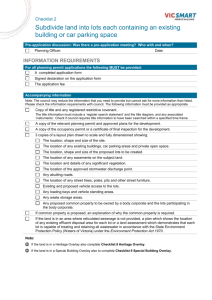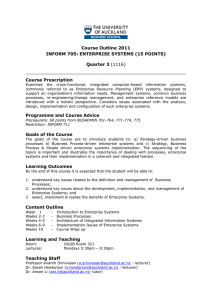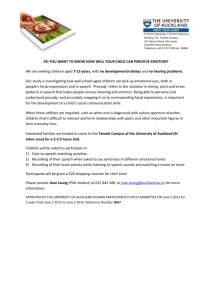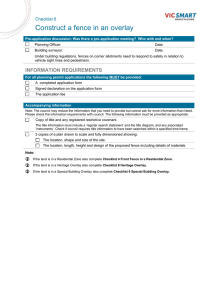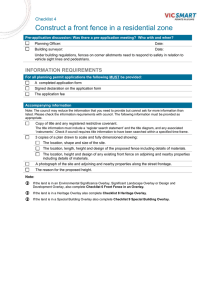7 Natural resources The Proposed Auckland Unitary Plan (notified
advertisement
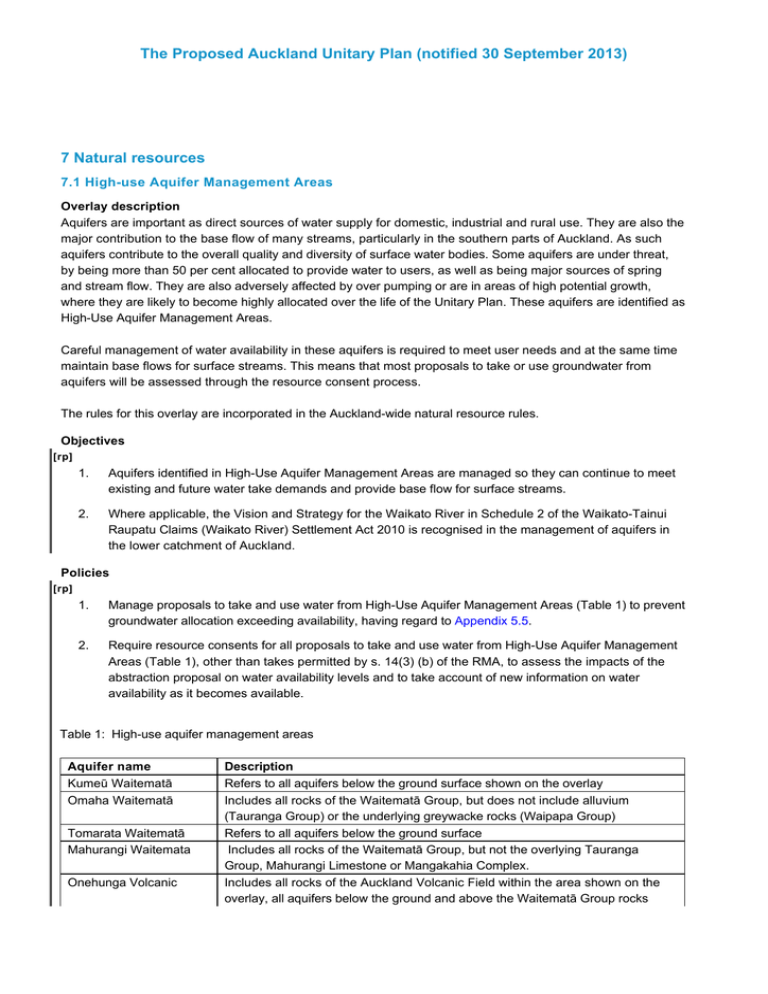
The Proposed Auckland Unitary Plan (notified 30 September 2013) 7 Natural resources 7.1 High­use Aquifer Management Areas Overlay description Aquifers are important as direct sources of water supply for domestic, industrial and rural use. They are also the major contribution to the base flow of many streams, particularly in the southern parts of Auckland. As such aquifers contribute to the overall quality and diversity of surface water bodies. Some aquifers are under threat, by being more than 50 per cent allocated to provide water to users, as well as being major sources of spring and stream flow. They are also adversely affected by over pumping or are in areas of high potential growth, where they are likely to become highly allocated over the life of the Unitary Plan. These aquifers are identified as High­Use Aquifer Management Areas. Careful management of water availability in these aquifers is required to meet user needs and at the same time maintain base flows for surface streams. This means that most proposals to take or use groundwater from aquifers will be assessed through the resource consent process. The rules for this overlay are incorporated in the Auckland­wide natural resource rules. Objectives [rp] 1. Aquifers identified in High­Use Aquifer Management Areas are managed so they can continue to meet existing and future water take demands and provide base flow for surface streams. 2. Where applicable, the Vision and Strategy for the Waikato River in Schedule 2 of the Waikato­Tainui Raupatu Claims (Waikato River) Settlement Act 2010 is recognised in the management of aquifers in the lower catchment of Auckland. Policies [rp] 1. Manage proposals to take and use water from High­Use Aquifer Management Areas (Table 1) to prevent groundwater allocation exceeding availability, having regard to Appendix 5.5. 2. Require resource consents for all proposals to take and use water from High­Use Aquifer Management Areas (Table 1), other than takes permitted by s. 14(3) (b) of the RMA, to assess the impacts of the abstraction proposal on water availability levels and to take account of new information on water availability as it becomes available. Table 1: High­use aquifer management areas Aquifer name Kumeū Waitematā Omaha Waitematā Tomarata Waitematā Mahurangi Waitemata Onehunga Volcanic Description Refers to all aquifers below the ground surface shown on the overlay Includes all rocks of the Waitematā Group, but does not include alluvium (Tauranga Group) or the underlying greywacke rocks (Waipapa Group) Refers to all aquifers below the ground surface Includes all rocks of the Waitematā Group, but not the overlying Tauranga Group, Mahurangi Limestone or Mangakahia Complex. Includes all rocks of the Auckland Volcanic Field within the area shown on the overlay, all aquifers below the ground and above the Waitematā Group rocks The Proposed Auckland Unitary Plan (notified 30 September 2013) Aquifer name Mt Wellington Volcanic Waiheke Manukau Waitematā Manukau Southeast Kaawa Clevedon East Waitematā Clevedon West Waitematā Franklin Volcanic Franklin Kaawa Drury Sand Waiwera Geothermal Parakai Geothermal Description Includes all rocks of the Auckland Volcanic Field within the area shown on the overlay, all aquifers below the ground and above the Waitematā Group rocks. Refers to all aquifers Includes all rocks of the Waitematā Group, but not the overlaying Tauranga Group or Kaawa Formation Refers to Kaawa Formation only. It may be overlain by Auckland volcanic field or Tauranga Group which are not included. The underlying Waitematā Group is not included. Includes all rocks of the Waitematā Group, but not the underlying greywacke (Waipapa Group) or the overlying Tauranga Group or Kaawa Formation Includes all rocks of the Waitematā Group, but not the underlying greywacke (Waipapa Group) or the overlying Tauranga Group or Kaawa Formation Comprises the following aquifers: i. Bombay volcanic ii. Glenbrook volcanic iii. Pukekohe North Volcanic 2012 iv. Pukekohe South Volcanic 2012 (in Auckland Council area only) Includes all aquifers from the ground surface to the base of the South Auckland volcanic field, but not the underlying Kaawa Formation or Waitematā Group Comprises the following sub­zones i. Franklin Kaawa West ii. Franklin Kaawa East Refers to Kaawa Formation only. It may be overlain by South Auckland volcanic field or Tauranga Group which are not included. The underlying Waitematā Group is not included Includes Tauranga Group and Kaawa Formation but does not include overlying South Auckland volcanic field or underlying Waitematā Group Refers to all geothermal aquifers below the ground surface Refers to all geothermal aquifers below the ground surface Notes: 1. Plan users are referred to Geology of the Auckland Area, 1:250,000 Geological Map 3, Institute of Geological and Nuclear Sciences, Edbrooke (2001), for further guidance. 2. The spatial extent of these aquifers on the ground surface under which the aquifers are located is identified on the aquifers overla However, the three­dimensional nature of aquifers is difficult to portray on a map. There may be more than one aquifer under the areas identified on the overlay. Only the aquifers listed above are High­Use Aquifer Management Areas. Aquifers not listed above, but located under the areas identified on the aquifers overlay are not High­Use Aquifer Management Areas. The Proposed Auckland Unitary Plan (notified 30 September 2013) 7.2 Quality­sensitive Aquifer Management Areas Overlay description These aquifers are shallow and unconfined and therefore susceptible to pollution from surface sources, such as excess fertiliser application or discharges of contaminants such as stormwater or sewage. The potential for contamination is highest in the volcanic aquifers where discharge to aquifers is most direct. They are important sources of water for rural and industrial purposes, as well as providing base flow to surface streams in some areas. Rules for this overlay are incorporated in the Auckland­wide natural resource rules. Objective [rp] 1. Rivers and streams in Auckland with high natural character and high ecological values are protected. Policies [rp] 1. Recognise the sensitivity of the following aquifers to groundwater contamination and minimise the discharge of contaminants in these Quality­Sensitive Aquifer Management Areas: a. rural aquifers ­ Kaipara sand, Franklin volcanic and Āwhitu sand b. urban aquifers ­ Auckland isthmus volcanics, including the Onehunga and Mt Wellington aquifers. 2. Discourage the discharge of contaminants where they are likely to have significant adverse effects on groundwater quality within Quality­Sensitive Aquifer Management Areas. 3. Maintain the quality of the Onehunga aquifer as a source of municipal water supply for Auckland and minimise the risk of chemical spills into ground or into stormwater drains in the catchment. The Proposed Auckland Unitary Plan (notified 30 September 2013) 7.3 High­use Stream Management Areas Overlay description A number of streams in Auckland are under pressure from demands to take water, or use water for a number of purposes. The high use of these streams creates conflicts between the amount of water being abstracted, the amount of water needed to be left in the stream for other uses, such as assimilating the adverse effects of discharges, and the amount of water required to maintain ecological values and base flows. Management of high­use streams can be particularly difficult during summer months when stream flows are generally at their lowest. Rules for this overlay are incorporated in the Auckland­wide natural resource rules. Objectives [rp] 1. Water continues to be available from high­use streams while safeguarding the life­supporting capacity and amenity values. 2. Where applicable, the Vision and Strategy for the Waikato River in Schedule 2 of the Waikato­Tainui Raupatu Claims (Waikato River) Settlement Act 2010 is recognised. Policies [rp] 1. Manage the following streams as High­Use Stream Management Areas which includes all the streams within the following catchments and sub­catchments: a. Whangaripo stream, a sub­catchment of the Hōteo river catchment b. Mahurangi river c. Waitoki, Waikahikatea and Waipapakura streams, sub­catchments of the Kaukapakapa river catchment d. Waimauku stream and Kumeū river, sub­catchments of the Kaipara river catchment e. Puhinui stream in Manukau area f. 2. 3. Taitaia stream, a sub­catchment of the Wairoa river catchment g. Hays creek in Papakura area h. Ngakoroa, Mauku and Waitangi streams in the Franklin area. Require proposals that take or use water from a High­Use Stream Management Area to: a. ensure that other water takes can continue to operate b. maintain in stream ecological and Mana Whenua values c. maintain the stream's amenity values. Proposals to discharge contaminants into high­use streams or into or onto land where they may percolate into high­use streams, must avoid, remedy or mitigate their adverse effects on other uses of these streams and, in particular avoid reducing their assimilative capacity. The Proposed Auckland Unitary Plan (notified 30 September 2013) 7.4 Natural Stream Management Areas Overlay description The Natural Stream Management Areas overlay is comprised of river and stream reaches with high natural character and high ecological values. Natural Stream Management Areas generally have an unmodified river or stream bed with existing indigenous riparian vegetation on both sides. The presence of indigenous riparian vegetation indicates that the river or stream has high ecological values and water quality, keeping water temperatures constant and filtering contaminants and sediments from surface flows entering the stream. Natural Stream Management Areas are important for native fish and macro­invertebrates particularly providing fish passage, habitat, food sources and breeding areas. Many Natural Stream Management Areas are located in the upper reaches of a catchment or in reserve areas with generally high water quality. The combination of suitable temperature, pH and water quality and the presence of native aquatic plants and aquatic fauna are collectively referred to as "in­stream values". The rules for this overlay are incorporated in the Auckland­wide natural resource rules. Objective [rp] 1. Rivers and streams in Auckland with high natural character and high ecological values are protected. Policies [rp] 1. Identify and protect the in­stream values and riparian margins of Natural Stream Management Areas, which are areas of rivers and streams and associated riparian vegetation that meet the following criteria: a. any river or stream with predominantly indigenous riparian vegetation cover along a length (reach) of at least 600m and: i. an average total width of vegetation cover of 80m i.e. an average width of 40m on either side ii. b. a minimum total width of vegetation cover of 10m from the stream edge for a length not exceeding 10 per cent of the total reach where there are cleared areas for tracks and stream crossings, these are included in the measurements of vegetation length and width. 2. Allow water takes and contaminant discharges only where they are of a scale and type that protects the in­stream values of these rivers and streams. 3. Maintain and where possible enhance fish passage between the CMA and the upstream extent of these Natural Stream Management Areas. 4. Avoid structures and activities in Natural Stream Management Areas that disturb, damage, remove or replace the natural bed and course of the river or stream and its associated indigenous riparian vegetation. Note: A Natural Stream Management Area may be determined from measurements taken from an aerial photograph or an accurately scaled plan. Natural Stream Management Areas are shown indicatively in this overlay. To avoid doubt, the criteria stated in Policy 1 above are the primary reference for defining these areas. Compliance will be determined with reference to the criteria in Policy 1 and not the mapped overlay. The Proposed Auckland Unitary Plan (notified 30 September 2013) 7.5 Stormwater Management Area ­ flow Overlay description The Stormwater Management Area: Flow overlay seeks to protect and enhance Auckland's rivers, streams and aquatic biodiversity in urban areas. Auckland has numerous small and narrow urban rivers and streams. Despite their small size, these rivers and streams are home to much of our freshwater aquatic biodiversity and have amenity values. These values are threatened by the effects of on­going urban development. The creation of impervious surfaces in a catchment undergoing development increases the flow rate and volume of stormwater runoff. This change in hydrology, unless managed, can have a significant adverse effect on streams within the catchment, including accelerating river and stream erosion and bank instability, particularly in steeper upper catchment areas, and creating hydrological conditions that do not support healthy aquatic ecosystems. In developed urban catchments with large areas of impervious surface, increased runoff is one of the primary causes of degraded river and stream health, and also causes loss of land (including undermining buildings) and amenity values. However, in areas that are yet to be developed, or where development is at low levels, development can be enabled while also protecting and enhancing in­stream biodiversity and other river and stream values by reducing and managing stormwater runoff, and other measures such as enhancing riparian margins. Redevelopment also offers an opportunity to reduce existing adverse effects and enhance river and stream values. The Stormwater Management Area: Flow (SMAF) overlay maps rivers and streams (and their contributing catchments) that are particularly susceptible to the effects of development or have relatively high values. SMAF 1 areas are those catchments which discharge to sensitive or high value streams that have relatively low levels of existing impervious area. SMAF 2 areas typically discharge to streams with moderate to high values and sensitivity to stormwater, but generally with higher levels of existing impervious area within the catchment. In these SMAF areas, future development and redevelopment is still enabled, but it is subject to controls to reduce stormwater runoff to protect Auckland’s aquatic biodiversity and other values from further decline and enhance them where possible. Rules for this overlay are incorporated in the Auckland­wide natural resource rules. Objective [rp] 1. High­value rivers, streams and aquatic biodiversity in identified catchments are protected from the adverse effects of stormwater runoff associated with urban development and where possible enhanced. Policies [rp] 1. Manage stormwater runoff from impervious areas in SMAF 1 and 2 areas to ensure the adequate functioning and performance of the stormwater network, minimise the adverse effects of stormwater runoff on rivers and streams to retain, and where possible enhance, stream naturalness, biodiversity, bank stability and other values. 2. Apply stormwater hydrology mitigation in SMAF 1 and 2 areas to: a. new impervious areas b. redeveloped impervious areas c. entire sites where the area of development or redevelopment comprises more than 50 per cent of the site area. The Proposed Auckland Unitary Plan (notified 30 September 2013) 7.6 Natural Lake Management Areas Overlay description The Natural Lake Management Areas overlay applies to natural lakes located in rural Auckland. This includes the total lake surface area and a 50m buffer strip surrounding the lake edge, measured landward from the mean annual water level. These lakes are located in three main areas ­ South Kaipara Peninsula, north­east coast inland of Pākiri Beach, and Āwhitu Peninsula. Natural lakes are typically fed by small streams and overland flow with minimal outflows. Water levels of natural lakes are dependent on groundwater hydrogeology, water uptake rates by vegetation and water takes. Natural lakes in Auckland offer a wide range of uses such as seasonal boating and other surface water recreational activities, many of which are located in significant areas of public reserve and parks. Natural Lake Management Areas with high water quality, indigenous vegetation and wetlands present important habitats for biodiversity. However, not all Natural Lake Management Areas are in pristine condition, with varying water quality, quantity, ecological values, recreational values and land use within catchments. Many natural lakes suffer from poor water quality due to nutrient and sediment runoff from surrounding land. The presence of invasive pest species also adversely affect Natural Lake Management Areas. The rules for this overlay are incorporated in the Auckland­wide natural resource rules. Objectives [rp] 1. Water quality is maintained or enhanced in lakes within Natural Lake Management Areas. 2. High natural character and ecological values of Natural Lake Management Areas are maintained or enhanced. 3. High natural character and ecological values of Natural Lake Management Areas are not adversely affected by recreational use. Policies [rp] 1. Maintain or enhance water quality by avoiding direct and diffuse discharges of contaminants into Natural Lake Management Areas. 2. Minimise adverse effects on lake water levels of Natural Lake Management Areas by avoiding new proposals to take, use or divert surface and groundwater from natural lakes and restrict water allocation to existing water users. 3. Avoid adverse effects on the hydrology in Natural Lake Management Areas from new exotic forestry that are more than minor. 4. Maintain and enhance the margins of Natural Lake Management Areas by: a. maintaining and enhancing indigenous vegetation within 50m setback 5. b. excluding livestock from the wetted perimeter of the lakes including banks c. avoiding structures within 50m setback, excluding fences or facilities to support recreational activities. Enable recreational activities in Natural Lake Management Areas: a. where they are low­impact activities such as non­motorised boating b. by limiting the use of motorised boating to Lake Tomarata and Lake Spectacle c. any moored structures are located to avoid conflict with other uses and do not adversely affect The Proposed Auckland Unitary Plan (notified 30 September 2013) safety and health of individuals d. 6. existing recreational facilities are utilised efficiently to avoid the erection of new jetties, ramps and other similar structures. Avoid the release of invasive pest species into Natural Lake Management Areas. The Proposed Auckland Unitary Plan (notified 30 September 2013) 7.7 Urban Lake Management Areas Overlay description The Urban Lake Management Areas overlay comprises Lake Pupuke and Western Springs Lake. Lake Pupuke is formed from an old volcano and is characterised by the absence of any streams, with the movement of groundwater as its main source of recharge and discharge. Lake Pupuke is surrounded by residential and commercial development. Areas of publicly owned land are interspersed with residential development fronting onto the lake shore. Western Springs Lake derives its water source from groundwater flow, and has an outlet via a weir to Motions Creek. Western Springs Lake is surrounded by a public reserve. Both lakes are important for their open­space, recreational and amenity values. The main impacts on the water quality of Lake Pupuke come from the contaminants in stormwater discharges into the lake, wastewater overflows and fertiliser runoff from surrounding private gardens and the public reserve. Western Springs has a lower water quality, mainly due to contamination from faecal matter associated with the water fowl population. The rules for this overlay are incorporated in the Auckland­wide natural resource rules. Objectives [rp] 1. Open­space, recreational and amenity values of Urban Lake Management Areas are maintained or enhanced. 2. Water quality of lakes in Urban Lake Management Areas is maintained or enhanced to support ecosystem health, recreational and amenity values. 3. Margins of lakes in Urban Lake Management Areas are maintained or enhanced. Policies [rp] 1. Avoid further modification of margins by reclamation and minimise shoreline protection works in Urban Lake Management Areas. 2. Maintain or enhance open­space, recreational and amenity values of the Urban Lake Management Areas by minimising structures in, on or over lake bed and surface water. 3. Minimise discharges of contaminants to Urban Lake Management Areas. 4. Avoid the significant disturbance of lake beds to minimise suspended sediment and nutrients in water. 5. Recognise that stormwater maintains water levels in Urban Lake Management Areas, and support initiatives to treat these discharges. 6. Maintain and protect wetland vegetation in Urban Lake Management Areas by avoiding the disturbance from structures and vegetation clearance associated with significant infrastructure maintenance. The Proposed Auckland Unitary Plan (notified 30 September 2013) 7.8 Water Supply Management Areas Overlay description The purpose of Water Supply Management Areas is to provide for the ongoing operation, maintenance, upgrading and development of the municipal water supply infrastructure. The areas comprise the catchments that are mainly in public ownership surrounding municipal water supply infrastructure. This infrastructure includes five dams in the Waitākere Ranges, two reservoirs in the Hunua Ranges, the Hays Creek dam at Papakura and land owned by Watercare Services in the Riverhead Forest. The management area also includes all related supporting and connected water supply infrastructure, such as the pipe network and pumping stations, located within these catchments. They contain water supply networks that are classified in the Unitary Plan as significant infrastructure. Part of the water supply management area for the Hunua water supply infrastructure is now outside the Auckland region. Water Supply Management Areas, particularly those in the Waitākere and Hunua Ranges, contain a mix of vegetation cover. Large areas of significant indigenous vegetation meet the criteria for identification as Natural Stream Management Areas. The Waitākere water supply management area forms part of the wider Waitākere Ranges Heritage Area. One of the heritage features recognised by the Waitakere Ranges Heritage Area Act 2008 is the operation, maintenance and development of the public water catchment and supply system that services the needs of the people of Auckland. Rules for this overlay are incorporated in the Auckland­wide natural resource rules. Objectives [rp] 1. Municipal water supply infrastructure is able to operate and develop in Water Supply Management Areas. 2. Natural character, ecological, heritage, recreational and amenity values of water supply management areas are protected while the operational needs and development requirements of municipal water supply infrastructure are met. Policies [rp] 1. Enable the operation, maintenance, upgrading and development of structures and activities for the storage, distribution and treatment of municipal water supply in Water Supply Management Areas. 2. Avoid, remedy or mitigate adverse effects, including cumulative effects of structures, equipment or works and any discharges of water from dams, pipelines or other water treatment infrastructure on the natural character, ecological, heritage, recreational and amenity values of Natural Stream and Wetland Management Areas in Water Supply Management Areas. 3. Assess the effects of activities for municipal water supply in Water Supply Management Areas against the objectives and policies relating to water allocation the diversion of surface water and activities affecting the beds of lakes and rivers. 4. Advise operators of municipal water supply infrastructure of applications for resource consent that have the potential to adversely affect the quality and quantity of water within Water Supply Management Areas or to adversely affect the safe and efficient operation of the water supply infrastructure. The Proposed Auckland Unitary Plan (notified 30 September 2013) 7.9 Wetland Management Areas Overlay description The purpose of the Wetland Management Areas is to manage the adverse effects of contaminated discharges, water takes, wetland drainage, invasive pest species and the physical disturbance to wetlands, including wetland vegetation. Wetlands are one of Auckland’s rarest and most at­risk ecosystems, supporting valuable plant and animal communities. Furthermore, wetlands naturally filter contaminants and regulate water flow, reducing contaminants in water and the susceptibility of flooding. Wetlands also present important cultural, recreational and amenity values. The Wetland Management Areas overlay is comprised of significant wetlands listed in Appendix 5.3 of the Unitary Plan. Wetland Management Areas may also be identified as SEAs, and therefore provisions in the Unitary Plan relating to SEAs also apply. The rules for this overlay are incorporated in the Auckland­wide natural resource rules. Objective [rp] 1. High natural character and ecological values of Wetland Management Areas (including spatial extent) are maintained or enhanced. 2. Cultural, recreational and amenity values of Wetland Management Areas are maintained or enhanced. Policies [rp] 1. Maintain or enhance Wetland Management Areas by: a. improving water quality b. maintaining water levels to ensure ecosystem functionality and significant variations in water levels occur only through natural fluctuations c. avoiding the removal or degradation of wetland vegetation in, on, or adjacent to wetland d. avoiding adverse effects of any activity on ecological values e. maintaining the size and spatial extent of the wetland area by avoiding progressive loss of wetland area. 2. Recognise and provide for ecosystem functions of Wetland Management Areas, including attenuation of flooding and treatment of contaminated discharges only where adverse effects are less than minor and will not result in significant adverse effects on the ecological or cultural values of the wetland. 3. Avoid activities in, on or adjacent to Wetland Management Areas except where the activity: a. is for wetland conservation purposes, including invasive pest removal b. provides for public access and interpretative activities relating to high natural character and ecological values c. is for operation, maintenance, upgrading or replacement of existing or new significant infrastructure. The Proposed Auckland Unitary Plan (notified 30 September 2013) 7.10 Air Quality – Transport Corridor Separation Overlay description The Air Quality Transport Corridor Separation overlay applies to identified strategic traffic routes in urban Auckland. The width of the overlay varies depending on the volume of traffic carried by particular roads, or particular stretches of road. The purpose of the overlay is to avoid adverse air quality effects of vehicle emissions on land use activities involving people with particular sensitivities to these emissions. Young children are identified as a group with high sensitivity to the adverse effects of vehicle emissions in terms of their health and overall well­being. Objective [rp/dp] 1. Childcare facilities located near transport corridors are managed to reduce the adverse effects of vehicle emissions on children. Policies [rp/dp] 1. Avoid adverse effects on human health from vehicle emissions by discouraging new childcare facilities from locating within 150m of regional strategic network roads, and 70m of regional arterial network roads, as shown on the Air Quality Transport Corridor Separation overlay. 2. Require new childcare facilities within the overlay to be designed, constructed and operated to avoid, remedy or mitigate adverse health effects from vehicle emissions on children attending the facility. 3. Require applications for land use consent for childcare facilities locating within the overlay to demonstrate: a. how adverse health effects on children attending the facility will be avoided b. how the location and design of the activity and buildings comply with a. above c. that there is adequate separation from the roadway to any outdoor play areas to comply with a. above d. that air discharges from vehicles on the identified transport corridors have been assessed using best practice methods, such as modelling and monitoring, appropriate to the scale of the discharge and any potential adverse effects e. that the method proposed to avoid adverse health effects on the children does not have a practicable alternative that causes fewer health effects. The Proposed Auckland Unitary Plan (notified 30 September 2013) 7.11 Air Quality – Industry Transition Overlay description The Heavy Industry zone is a reduced air quality amenity area. This enables activities that require regional air discharge consents to be located in an area which has a lower amenity than what is generally accepted in other zones. Consequently the requirements for emissions control may be less stringent. For this reason heavy industry zones should ideally not be located within 500m of zones that provide for activities sensitive to air discharges. In some circumstances however, zones that provide for activities sensitive to air discharges have encroached within this 500m distance. The purpose of the overlay is to ensure that industries that require regional air discharge consents do not have adverse effects on activities that are sensitive to air discharges. The Air Quality – Industry Transition overlay applies to areas of the Heavy Industry zone that are located within 500m of the edge of the following zones: • residential zones that allow a density of more than one dwelling per site (eg Mixed Housing Urban, Mixed Housing Suburban, Terraced Housing and Apartment zones) • all business zones that allow residential activity (Metropolitan Centre, Town Centre, Local Centre, Neighbourhood Centre and Mixed Use) Where the heavy industry zone is adjacent to other zones (eg Light Industry, Single House), see the Air Quality – Sensitive Activity Restriction overlay. The overlay is a policy overlay. It does not change the activity status of land use activities within the overlay area. It provides additional objectives and policies that must be considered when assessing a proposal for a resource consent or a plan change. Objectives [rp] 1. Significant adverse effects of industrial air discharges on health, property and the environment are avoided. 2. Incompatible land uses and activities are separated and reverse sensitivity conflicts are avoided. Policies [rp] 1. Maintain adequate separation distances between activities with air discharges and activities sensitive to air discharges. 2. Locate the Air Quality – Industry Transition overlay within the heavy industry zone to a distance of 500m from the edge of the following zones: a. City Centre zone b. Metropolitan Centre zone c. Town Centre zone d. Local Centre zone e. Neighbourhood Centre zone f. Mixed Use zone g. Mixed Housing Urban zone h. Mixed Housing Suburban zone i. Terraced Housing and Apartment zone The Proposed Auckland Unitary Plan (notified 30 September 2013) 3. j. Healthcare Facility zone k. Retirement Village zone. Avoid locating activities that require air discharge consents in the Air Quality ­ Industry Transition overlay unless it can be shown that adverse effects on activities sensitive to air discharges can be avoided, remedied or mitigated. The Proposed Auckland Unitary Plan (notified 30 September 2013) 7.12 Air Quality – Sensitive Activity Restriction Overlay description The Heavy Industry zone is a reduced air quality amenity area. This enables activities that require regional air discharge consents to be located in an area which has a lower amenity than what is generally accepted in other zones. Consequently the requirements for emissions control may be less stringent. For this reason heavy industry zones should ideally not be located within 500m of zones that provide for activities sensitive to air discharges. In some circumstances however, zones that provide for activities sensitive to air discharges have encroached within this 500m distance. The purpose of the overlay is to prevent activities sensitive to air discharges establishing close to a Heavy Industry zone. This will ensure that industries’ ability to obtain air discharge consents is not restricted by the close proximity of activities sensitive to air discharges. It will also ensure that industries that require regional air discharge consents do not have adverse effects on activities that are sensitive to air discharges. In greenfield areas the overlay will surround the Heavy Industry zone to a distance of 500m from the Heavy Industry zone edge, to prevent zones that provide for activities sensitive to air discharges from locating in close proximity. In brownfield areas, where the zone surrounding the Heavy Industry zone does not provide for activities sensitive to air discharges (eg the Light Industry zone, General Business zone) the overlay will also be applied to a distance of 500m from the Heavy Industry zone edge. In some cases however there are existing zones that provide for activities sensitive to air discharges within 500m of the Heavy Industry zone edge. In these situations; 1. where it is one of the following zones, the Air Quality – Industry Transition overlay is applied over the relevant area of the Heavy Industry zone; a. residential zones allowing a density of more than one dwelling per site (eg Mixed Housing Urban, Mixed Housing Suburban, Terraced Housing and Apartment zones) b. 2. all business zones that allow residential activity (Metropolitan Centre, Town Centre, Local Centre, Neighbourhood Centre and Mixed Use) where the zone permits lower intensity activities that are sensitive to air discharges (eg Single House zone, Countryside Living zone), the Air Quality – Sensitive Activities Restriction overlay is applied over these zones. Ideally these zones should not locate within 500m of a Heavy Industry zone, but as they are existing, the overlay is applied to ensure that sensitive activities in these zones are not intensified. This ensures that the reverse sensitivity problem is not exacerbated. Activities within the Heavy Industry zone are still required to adequately separate activities with air discharges from those activities sensitive to them, so the sensitive activities within these areas are still protected. The overlay is a policy overlay. It does not change the activity status of land use activities within the overlay area. It provides additional objectives and policies that must be considered when assessing a proposal for a resource consent or a plan change. Objectives [rp] 1. Significant adverse effects of industrial air discharges on health, property and the environment are avoided. 2. The efficiency of Heavy Industry zoned land is preserved. 3. Incompatible land uses and activities are separated and reverse sensitivity conflicts are avoided. The Proposed Auckland Unitary Plan (notified 30 September 2013) Policies [rp] 1. Maintain adequate separation distances between activities with air discharges and those sensitive to air discharges. 2. Locate the overlay so that: a. in greenfield areas the overlay surrounds the Heavy Industry zone to a distance of 500m from the Heavy Industry zone edge b. in brownfield areas the overlay surrounds the Heavy Industry zone to a distance of 500m from the Heavy Industry zone edge, except for any area within the 500m that is one of the following zones: i. City Centre zone ii. Metropolitan Centre zone iii. Town Centre zone iv. Local Centre zone v. Neighbourhood Centre zone vi. Mixed Use zone vii. Mixed Housing Urban zone viii. Mixed Housing Suburban zone ix. Terraced Housing and Apartment zone x. Healthcare Facility zone xi. Retirement Village zone. 3. Avoid locating zones within 500m of a Heavy Industry zone if they provide for activities sensitive to air discharges as permitted activities. 4. Avoid re­zoning land within 500m of a Heavy Industry zone to a zone with a higher residential density, or to a zone that allows activities that increase the potential for reverse sensitivity effects, unless it is an existing zone listed in Policy 2(b) above (on the date of notification of this Unitary Plan). 5. Avoid locating activities sensitive to air discharges within 500m of the Heavy Industry zone edge, unless the activity has: a. a permitted activity status; or b. it is within a zone listed in Policy 2(b) above (on the date of notification of this Unitary Plan).

